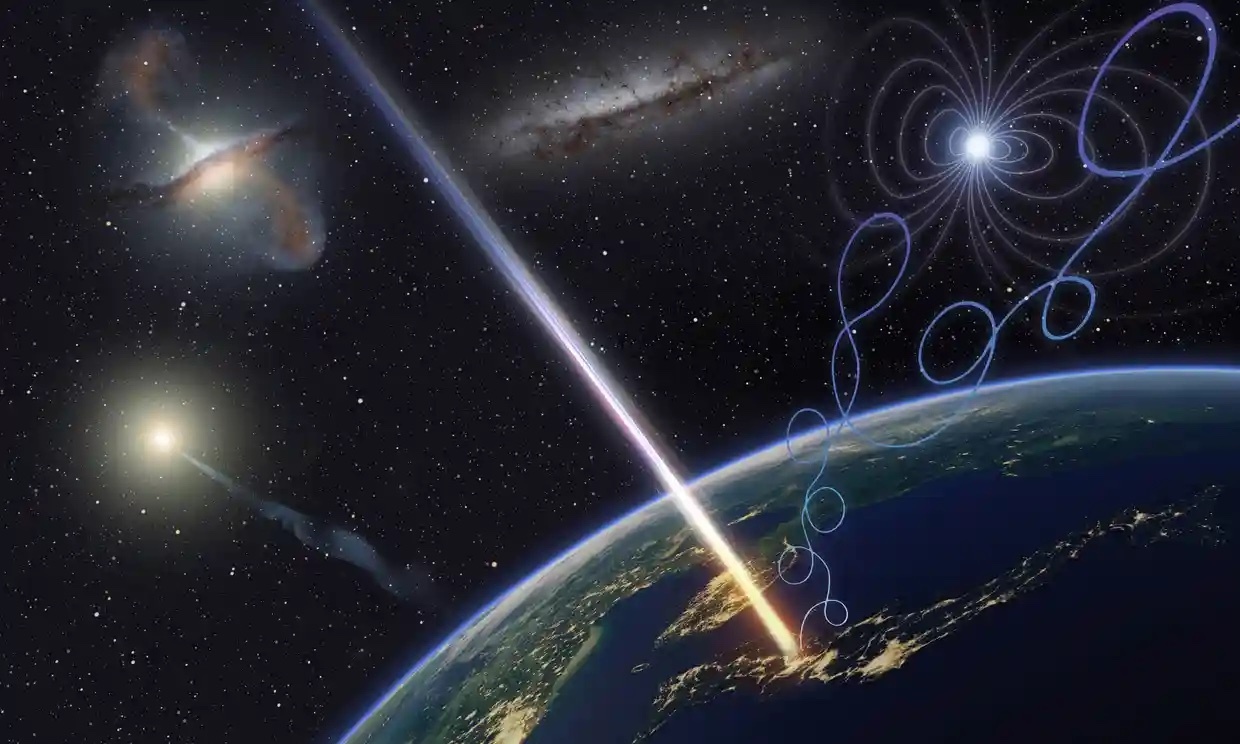25.11.2023
Amaterasu particle, one of highest-energy cosmic rays ever detected, is coming from an apparently empty region of space

Artist’s impression of the Amataresu particle. When ultra-high-energy cosmic rays hit Earth’s atmosphere, they initiate a cascade of secondary particles and electromagnetic radiation.Photograph: Osaka Metropolitan University/Kyoto University/Ryuunosuke Takeshige/PA
Astronomers have detected a rare and extremely high-energy particle falling to Earth that is causing bafflement because it is coming from an apparently empty region of space.
The particle, named Amaterasu after the sun goddess in Japanese mythology, is one of the highest-energy cosmic rays ever detected.
Only the most powerful cosmic events, on scales far exceeding the explosion of a star, are thought to be capable of producing such energetic particles. But Amaterasu appears to have emerged from the Local Void, an empty area of space bordering the Milky Way galaxy.
“You trace its trajectory to its source and there’s nothing high energy enough to have produced it,” said Prof John Matthews, of the University of Utah and a co-author of the paper in the journal Science that describes the discovery. “That’s the mystery of this – what the heck is going on?”
The Amaterasu particle has an energy exceeding 240 exa-electron volts (EeV), millions of times more than particles produced in the Large Hadron Collider, the most powerful accelerator ever built, and equivalent to the energy of a golf ball travelling at 95mph. It comes only second to the Oh-My-God particle, another ultra-high-energy cosmic ray that came in at 320 EeV, detected in 1991.
“Things that people think of as energetic, like supernova, are nowhere near energetic enough for this,” said Matthews. “You need huge amounts of energy, really high magnetic fields, to confine the particle while it gets accelerated.”
Toshihiro Fujii, an associate professor at Osaka Metropolitan University in Japan, said: “When I first discovered this ultra-high-energy cosmic ray, I thought there must have been a mistake, as it showed an energy level unprecedented in the last three decades.”
A potential candidate for this level of energy would be a super-massive black hole at the heart of another galaxy. In the vicinity of these vast entities, matter is stripped back to its subatomic structures and protons, electrons and nuclei are hurled out across the universe at nearly the speed of light.
Cosmic rays, echoes of such violent celestial events, rain down on to Earth nearly constantly and can be detected by instruments, such as the Telescope Array observatory in Utah, which found the Amaterasu particle.
Below a certain energy threshold, the flight path of these particles resembles a ball in a pinball machine as they zigzag against the electromagnetic fields through the cosmic microwave background. But particles with Oh-My-God or Amaterasu-level energy would be expected to blast through intergalactic space relatively unbent by galactic and extra-galactic magnetic fields, meaning it should be possible to trace their origin.
Tracing its trajectory backwards points towards empty space. Similarly, the Oh-My-God particle had no discernible source. Scientists suggest this could indicate a much larger magnetic deflection than predicted, an unidentified source in the Local Void, or an incomplete understanding of high-energy particle physics.
“These events seem like they’re coming from completely different places in the sky. It’s not like there’s one mysterious source,” said Prof John Belz of the University of Utah and a co-author of the paper. “It could be defects in the structure of spacetime, colliding cosmic strings. I mean, I’m just spitballing crazy ideas that people are coming up with because there’s not a conventional explanation.”
The Telescope Array is uniquely positioned to detect ultra-high-energy cosmic rays. It sits at about 1,200m (4,000ft), the elevation sweet spot that allows secondary particles maximum development, but before they start to decay. Its location in Utah’s West Desert provides ideal atmospheric conditions in two ways: the dry air is crucial because humidity will absorb the ultraviolet light necessary for detection; and the region’s dark skies are essential, as light pollution will create too much noise and obscure the cosmic rays.
The Telescope Array is in the middle of an expansion that that astronomers hope will help crack the case. Once completed, 500 new scintillator detectors will expand the Telescope Array across 2,900 km2 (1,100 mi2 ), an area nearly the size of Rhode Island and this larger footprint is expected to capture more of these extreme events.
